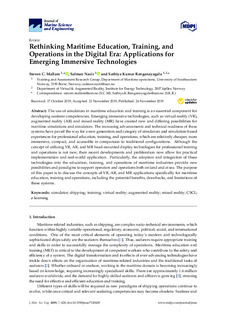| dc.contributor.author | Mallam, Steven | |
| dc.contributor.author | Nazir, Salman | |
| dc.contributor.author | Renganayagalu, Sathiya Kumar | |
| dc.date.accessioned | 2020-01-15T13:34:11Z | |
| dc.date.available | 2020-01-15T13:34:11Z | |
| dc.date.created | 2020-01-08T12:28:24Z | |
| dc.date.issued | 2019 | |
| dc.identifier.citation | Journal of Marine Science and Engineering. 2019. | nb_NO |
| dc.identifier.issn | 2077-1312 | |
| dc.identifier.uri | http://hdl.handle.net/11250/2636454 | |
| dc.description | Licensee MDPI, Basel, Switzerland. This article is an open access article distributed under the terms and conditions of the Creative Commons Attribution (CC BY) license | nb_NO |
| dc.description.abstract | The use of simulators in maritime education and training is an essential component for developing seafarer competencies. Emerging immersive technologies, such as virtual reality (VR), augmented reality (AR) and mixed reality (MR) have created new and differing possibilities for maritime simulations and simulators. The increasing advancements and technical readiness of these systems have paved the way for a new generation and category of simulators and simulation-based experiences for professional education, training, and operations, which are relatively cheaper, more immersive, compact, and accessible in comparison to traditional configurations. Although the concept of utilizing VR, AR, and MR head-mounted display technologies for professional training and operations is not new, their recent developments and proliferation now allow for practical implementation and real-world application. Particularly, the adoption and integration of these technologies into the education, training, and operations of maritime industries provide new possibilities and paradigms to support operators and operations both on land and at sea. The purpose of this paper is to discuss the concepts of VR, AR, and MR applications specifically for maritime education, training and operations, including the potential benefits, drawbacks, and limitations of these systems. View Full-Text | nb_NO |
| dc.language.iso | eng | nb_NO |
| dc.rights | Navngivelse 4.0 Internasjonal | * |
| dc.rights.uri | http://creativecommons.org/licenses/by/4.0/deed.no | * |
| dc.title | Rethinking Maritime Education, Training, and Operations in the Digital Era: Applications for Emerging Immersive Technologies | nb_NO |
| dc.type | Journal article | nb_NO |
| dc.type | Peer reviewed | nb_NO |
| dc.description.version | publishedVersion | nb_NO |
| dc.rights.holder | © 2019 by the authors. | nb_NO |
| dc.source.pagenumber | 9 | nb_NO |
| dc.source.journal | Journal of Marine Science and Engineering | nb_NO |
| dc.identifier.doi | 10.3390/jmse7120428 | |
| dc.identifier.cristin | 1768477 | |
| cristin.unitcode | 222,58,5,0 | |
| cristin.unitname | Institutt for maritime operasjoner | |
| cristin.ispublished | true | |
| cristin.fulltext | original | |
| cristin.qualitycode | 1 | |

